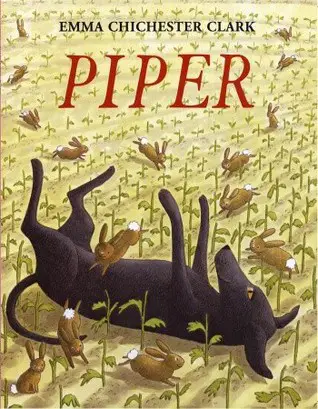This month I wrote a post on Teaching Kids How To Structure A Story. Today I continue with a selection of mentor texts to help kids see how it works. Let’s look closely at a picture book called Piper by Emma Chichester Clark. Piper is a bit of a maudlin tale, and Piper the dog is similar to characters like Oliver (by Charles Dickens). He really doesn’t have great luck in life. But then he does! My daughter called this a ‘happy-sad’ story, which is her word for ‘bittersweet’. This is an entirely un-ironic take on the ‘unlucky character finds a new home’ tale, which I plan to contrast with a similar but ironic picture book tomorrow.
STORY STRUCTURE OF PIPER
WHO IS THE MAIN CHARACTER?
This is Piper’s journey and Piper is clearly the main character. We can happily describe Piper as the hero, because he performs an heroic act and also because this is a mythic story. Main characters in mythic stories tend to be called heroes.
What is wrong with Piper?
Sometimes in children’s stories, the only thing wrong with a character is that they are vulnerable. Orphans are especially vulnerable. Piper is not exactly an orphan, but he is taken away from his mother and is therefore part of the orphan tradition of storytelling. Orphans are popular in children’s stories for a number of reasons, but mainly because it gets the protective parent out of the way. (All orphan stories owe something to Cinderella.)
Since he’s a dog, lack of ability to speak to humans is also a huge disadvantage.
WHAT DOES PIPER WANT?
Piper wants to find a new family and be happy with them.
OPPONENT/MONSTER/BADDIE/ENEMY/FRENEMY
The opponent is clearly the man who buys him, and expects him to chase/eat rabbits to protect the man’s garden. Later, even when Piper manages to run away, the man remains a constant threat, as he may at any time come to collect Piper, having paid for him.
WHAT’S PIPER’S PLAN?
Piper’s initial plan is to try and impress his new owner, but when that doesn’t work he’s at a loss. He has no substitute plan. From that point on, things happen to him.
Note that in stories, initial plans rarely work.
When things go belly-up, your main character doesn’t necessarily find a new plan right away, or at all. Alternatively, they might start with no plan because they like the status quo, but then they find one. In that case, they usually double down on that plan about halfway through the story.
Whether your main character has a plan right from the start or finds one partway through, characters do need plans. Otherwise they are not proactive, and readers don’t want to read stories about characters who just wait around. Characters with plans are also more likeable, so if you want to write a likeable main character, give them a desire and a plan early on. (Not all main characters need to be likeable, but it’s harder to write a good unlikeable one. You need to use lots of extra tricks.)
BIG STRUGGLE
I haven’t gone out of my way to collect mythic stories for this month’s exercise, which should give you some idea about the popularity of the ‘journey’ story.
In a plot with mythic structure, the main character will undergo a series of big struggles. Sure enough, Piper is hit by his new owner. Importantly, heroes on mythic journeys also meet characters who help them. These characters are often ‘mentors’. In this case, the rabbits repay Piper in kindness by bringing him lettuce, but note they can’t be of much use. That’s an important point about helper characters. They can offer emotional assistance and advice and sometimes they can provide objects which come in useful, but helpers can never solve the hero’s problems. It has to be the hero who gets him/herself out of bother, even if it’s entirely accidental. (As it is in this case!)
The Big Battle in an unironic mythic story is a near death experience. (Contrast Diary of a Wombat for an ironic take, in which Wombat is never in true danger.) The city setting provides lots of near death opportunities for dogs, who don’t know how to stay away from traffic. Therefore, Piper has a brush with death as he rescues an old lady from being hit badly by a car.
WHAT DOES PIPER LEARN?
When Piper is found injured under a bush he learns that humans can be kind as well as awful.
Kindness triumphs over evil. This is a simplistic message when you put it like this, but surprisingly popular in stories. I suppose we find it comforting. When you write out your own theme in a sentence like that, it’ll probably sound just as simple. That’s okay. It’s meant to. Just make sure you don’t say that sentence anywhere in the text. The theme has to be something readers discover for themselves.
HOW WILL PIPER’S LIFE BE DIFFERENT FROM NOW ON?
Piper has found a new home with a kind old lady. Their similar injuries (both have a broken ‘arm’) symbolise how well matched they are.
But the story doesn’t end with Piper and the old lady relaxing on the couch in the old lady’s home. That would have been enough to complete a narrative, but Emma Chichester Clark has written a fairly run-of-the-mill mythic plot until this moment, and whenever you do that you’re best to add a little extra. In this case, the Villain isn’t dead. He’s been off-stage and is therefore still useful.
The final section of this story focuses on Piper’s enduring anxiety about whether the abusive owner will turn up to collect him. Eventually we learn that he won’t. This is a very happy ending for Piper, and instead of a home-away-home story, we have a very similar home-away-NEW home structure.
Some people call these ‘found family’ stories. They tend to be heartwarming.

